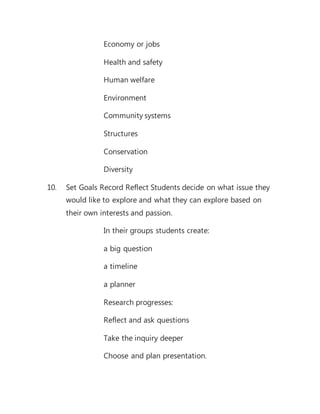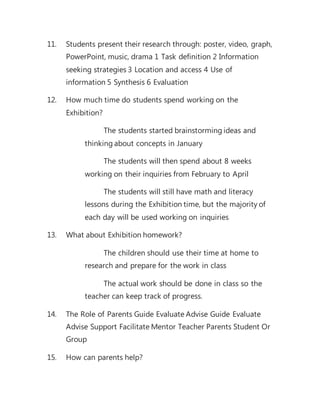The pyp exhibition parent presentation
- 1. The PYP Exhibition Parent Presentation - Presentation Transcript 1.The PYP Exhibition at the Parent Information Presentation International School of DĂĽsseldorf 2.What is the Exhibition? A culminating project for the PYP A collaborative inquiry that students have a personal interest in exploring An inquiry that requires students to apply their learning from previous years An experience that uses the essential elements of the PYP A demonstration of how students can take action as a result of their learning A celebration of who our students are as learners 3.What is the Exhibition? It is: Intense Tiring Exciting
- 2. Self-directed Process driven Rewarding Action provoking It is not: A science fair A poster contest A competition Individual Product driven Adult directed A burden 4.Students must use the PYP Transdisciplinary skills Communication Skills Social Skills Research skills Self-management skills Thinking skills 5.Students should show
- 3. Positive Attitudes: appreciation, commitment, confidence, cooperation, creativity, confidence, curiosity, empathy, enthusiasm, independence, integrity, respect, tolerance Learner Profiles: thinker, open-minded, caring, principled, reflective, inquirer, knowledgeable, risk-taker, communicator, well-balanced 6.Central Idea An inquiry into resources and issues in our local community. 7.Local Issues Matter to Me 8.What will the topics be? The topic and action should be something which effects the students’ life (school, family or local community) Ideally, students should have a high interest in the topic The topic should inspire students to take positive action 9.Possible areas of focus Scarcity or availability Change or adaptation
- 4. Economy or jobs Health and safety Human welfare Environment Community systems Structures Conservation Diversity 10. Set Goals Record Reflect Students decide on what issue they would like to explore and what they can explore based on their own interests and passion. In their groups students create: a big question a timeline a planner Research progresses: Reflect and ask questions Take the inquiry deeper Choose and plan presentation.
- 5. 11. Students present their research through: poster, video, graph, PowerPoint, music, drama 1 Task definition 2 Information seeking strategies 3 Location and access 4 Use of information 5 Synthesis 6 Evaluation 12. How much time do students spend working on the Exhibition? The students started brainstorming ideas and thinking about concepts in January The students will then spend about 8 weeks working on their inquiries from February to April The students will still have math and literacy lessons during the Exhibition time, but the majority of each day will be used working on inquiries 13. What about Exhibition homework? The children should use their time at home to research and prepare for the work in class The actual work should be done in class so the teacher can keep track of progress. 14. The Role of Parents Guide Evaluate Advise Guide Evaluate Advise Support Facilitate Mentor Teacher Parents Student Or Group 15. How can parents help?
- 6. Parents can: Ask your child about the Exhibition Support and encourage your child Provide background knowledge Help to locate resources – people, places, media and information Check WIKI website regularly with your child http:// exhibition.isdedu.wikispaces.net / Celebrate with the students by attending the final presentations 16. Develop Critical Thinking Ask your child open-ended questions about their project Let them solve their own problems Let them be responsible for their own learning Encourage independent inquiry and respect student ownership of the process Monitor, challenge, question, clarify. 17. How do we assess students’ work? “ Exhibitions are the best way to measure learning
- 7. because they put the kids right in the midst of their learning.” Dennis Litky We assess the process more than the product The students will keep a journal throughout the Exhibition process that shows how their thinking and goals are evolving Student self-assessment using rubrics Teacher assessment using rubrics. 18. Rubrics The rubrics assess the PYP Transdisciplinary skills, processes and attitudes Though the end product is assessed, the emphasis is on the process. 19. Something for us all to remember… The process is more important than the product The Exhibition is a celebration of who your child is as a learner. `







